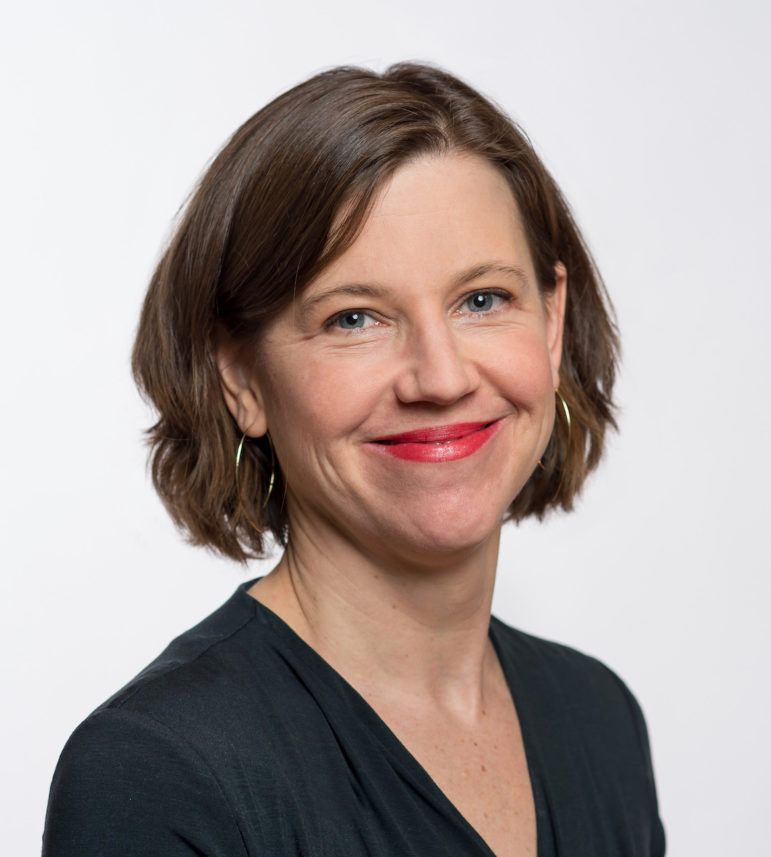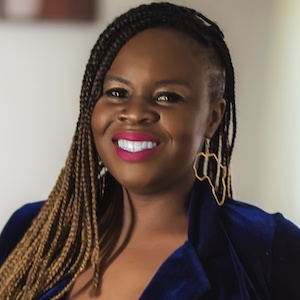How public radio’s ‘The Middle’ seeks overlooked perspectives between the coasts

Illinois Public Media
Jeremy Hobson, host of "The Middle" (center), speaks with Cynthia Wang (right), an expert on conflict resolution at Northwestern University's Kellogg School of Management, on the evening of Sept. 28. Tolliver, the show's house DJ, is at left.
Jeremy Hobson started his career in public radio when he was just nine years old on a kids’ show from Illinois Public Media. He went on to co-host NPR’s Here & Now, produced in Boston, and host Marketplace Morning Report from New York.
As host and EP of the new call-in show The Middle, he’s returning to his roots with a program dedicated to what happens between the coasts in America’s geographic, political and ideological middle.
The weekly hourlong show officially launched Sept. 28 and now airs on more than 375 public radio stations, typically on Thursday evenings. The format sees guest experts discuss a given topic, with the majority of each episode dedicated to live calls from listeners across the country.
“The idea of the show is to bring the voices of people who want to meet in the middle on important issues into the national conversation, people who are interested in having civil conversation with people that disagree,” Hobson says.
Episode subjects so far have included the opioid crisis, whether America’s leaders are too old, and — fittingly for the show’s ethos — how to talk politics with people you disagree with.
Hobson believes it’s the only national public radio program that takes live calls and says it’s distinct from the popular live call-in shows on commercial radio: “On those shows, if you disagree with the host’s opinions, it’s going to be the last stop.”
Being live offers “a level of authenticity” over a prerecorded show, he adds, giving more power to listeners, who can directly take part on air.
It’s a draw for stations, too. “There are so many things on my schedule that can be time-shifted; a live call-in isn’t one of them. I love live radio,” says Minnesota Public Radio PD Stephanie Curtis, whose station broadcasts The Middle. “It’s a differentiator for us.”
Developing the concept
The project started a year and a half ago. Having hosted daytime and morning shows for seven-and-a-half years, Hobson wanted to do a live show in the evening, a time when most stations air only prerecorded shows. After he pitched the idea to stations on the coasts, a conversation with a friend at WBEZ in Chicago inspired him to refine the concept. “You’re from central Illinois,” his friend said. “What if the show originated from stations in the middle of the country?”
Hobson shared the idea with stations, including Louisville Public Media, KERA in Dallas and WYFI in Indianapolis, which all expressed interest. He started developing the show with the help of former PRX CCO John Barth.
“The idea became: Let’s bring the voices of the geographic middle into the national conversation — voices that are so important politically but so often ignored by the media,” says Hobson.
During the 2022 midterms, Illinois Public Media produced four pilot episodes as a proof of concept. It aired on over 500 stations. “We went nationwide for four weeks and then went about fundraising to make the show work on a long-term basis,” says Hobson.
IPM is now the show’s broadcast partner. “We loved the idea of bringing call-in radio back to public radio and of a program that focuses on everyday Americans,” says Moss Bresnahan, executive director of IPM. “It’s elevating the voices of people who live in the heartland and of those interested in solutions and not just shouting at each other.”
The middle moment
With the 2024 presidential election looming, hearing more voices from the middle has never been more politically important, says Hobson.
“Presidential elections are not won in New York, California and Washington, D.C., where all of the media are; they are won in Wisconsin and Michigan, in Georgia and Arizona, and other states across the vast middle,” he says.
Recent political events show the middle’s power, too: Kansas voters supporting abortion rights in 2022 became “one of the most important moments in the mid-term election cycle,” says Hobson, while bipartisan support in Congress helped end the country’s debt-ceiling crisis in January.

“It’s important for people to hear themselves reflected in the media, and this program focuses specifically on people in ‘the middle,’ both politically and geographically, which is a great perspective for us to bring to Coloradans,” says Gillian Coldsnow, program director for Colorado Public Radio News.
As well as a younger and more diverse audience, public radio needs to welcome more people of different ideologies around the country into its listenership, says Hobson. According to data released by NPR in 2019, 54% of NPR news listeners consider themselves somewhat or very liberal, compared to 17% who consider themselves somewhat or very conservative. A further 26% described themselves as “middle of the road.”
Big topics, quality callers
The Middle’s team wants to tackle big ideas with its audience. Episodes looking ahead to a potential government shutdown and on artificial intelligence, weight-loss drugs and bipartisanship are all in the works.
As a live show, it’s not afraid to respond to the news cycle: It changed course to put out an Oct. 12 show about Israel and Gaza, and its Nov. 9 episode was pegged to the Ohio vote on abortion rights.
Before launch, Hobson says some station leaders raised concerns that the show would only attract older listeners, but that hasn’t been the case. The “call of the week” from the show’s second episode was a moving call from Macy, a teenager in Minnesota who shared how they had found a middle ground with their grandfather after coming out as transgender.
Hobson estimates that 90% of stations are airing the show live, bringing 200 calls an hour into the call system.
The Middle isn’t the first public radio program that’s wanted to appeal to a “middle” audience: Former Takeaway co-host Celeste Headlee’s weekly show and podcast Middle Ground ran from September 2013 to May 2014, while MPR’s live call-in show Flyover, from “between the coasts and across the aisle,” aired for three seasons from August 2017 to March 2020. “We loved that show, but it was not part of our company’s strategic plan,” says MPR’s Curtis. “It was driven by the content team and needed more support than distribution or marketing could give it.”

Flyover had a great directing team of “top-notch” call screeners, says Curtis, something The Middle needs to succeed, too. The Middle uses social media pre-show to connect with callers on topics, and iHeartRadio has also promoted the show’s podcast on its podcasts and terrestrial radio stations. Hobson also went on a radio tour of iHeart stations to promote the radio show and podcast.
“Combining a podcast audience with a public radio audience brings “even more diversity of thought,” says Hobson: “Our listeners are comfortable sharing a diverse range of opinions, even if it’s not the view that they think everybody else who’s listening has.”
Hobson says he doesn’t have any numbers on the broadcast audience yet and isn’t able to share podcast download figures. Initial indications suggest Colorado has been a huge driver of calls, while Denver and Minneapolis are two of the show’s top cities for podcast downloads.
Challenges: positioning and fundraising
Jason Loviglio, an associate professor of media and communication studies at the University of Maryland, Baltimore County, and a radio and podcasting researcher and author, says he can see the appeal of the live call-in format. It’s “a kind of metaphor for democracy,” he says.
But Loviglio suggests that adopting a middle ground tonally, away from the emotion and heat of more right-wing political, commercial media or the cool intellectual style associated with NPR, could pose a challenge to engaging audiences.
“Tone is extremely important to The Middle,” says Hobson. “The approach we are taking is to enter the conversation without predetermined judgments so that we can, as much as possible, avoid categorizing people into left- or right-wing and listen to each other as people first.”
The idea of a middle America comes with strong historical connotations, suggests Loviglio: “It has always been used to promote racially and ideologically conservative values.”
Hobson is confident the show can confront these associations, not by telling the audience what to think but rather by helping listeners find new common ground for the future.
“We want to break down the stereotypes and show what the geographic middle of the country actually is,” he says. “That undoubtedly includes showing the racial diversity as well as economic, gender identity, sexual orientation and ideological diversity that exists in the middle while also recognizing the inherent biases we all carry with us.”
So far, the biggest test has been using a new phone system that allows the call screeners and Hobson to work from anywhere: “For the first two weeks, we overloaded the system and we could only get one call at a time.”
Fundraising is also a challenge, says Hobson, who says The Middle is produced for a cost similar to a local talk show in a major market — very low compared to shows he’s worked on previously. A mostly part-time, six-person team working remotely helps keep down costs, which is good for stations, too. “Stations are going to discover that this show is going to bring a new audience to them and add some energy, especially if they’re running it in the evening,” he says.
Hobson is learning new skills to make the show sustainable but believes with the support of broadcast partners and iHeartRadio it can continue in perpetuity: “In the long run, we’re going to find every dollar that we need to make this show the best show it can be.”






